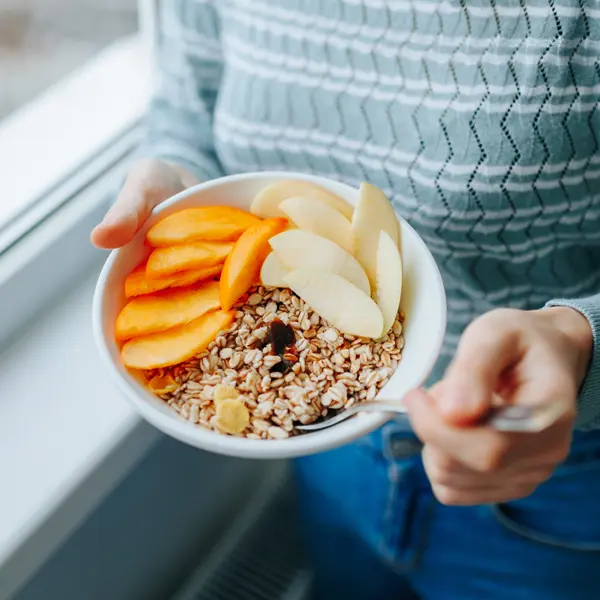Low Fiber Foods: The Silent Culprits of Digestive issues
When your schedule is packed, it’s easy to prioritize convenience over nutrition. You might grab something quick between tasks or rely on fast food to get through the day. It’s understandable, but here’s what you might not realize: many of those choices are low in fiber, an essential nutrient that helps keep your digestion, energy, and overall health on track.
You might be wondering, what’s the big deal about fiber, anyway? Read on to discover how having a low-fiber diet can affect your body. Moreover, find out how you can sneak more fiber with the help of Glucopro® into your routine.
Why Fiber Matters So Much
Unlike most nutrients, dietary fiber isn’t digested by your body—and that’s what makes it beneficial.1 As it travels through your digestive system undigested, fiber works behind the scenes to support gut health.1 It adds bulk to stool, makes stool easier to pass, helps prevent constipation, and provides nourishment for the good bacteria in your gut.1
The Problem with Low-Fiber Intake
Here are some of the risks associated with consistently low fiber intake:
Irregular Bowel Movements
Without enough bulk to move things along, the risk of constipation increases.2 Over time, this can lead to discomfort, bloating, irregular bowel movements, and in some cases, more serious issues like hemorrhoids or diverticulitis (small pouches in the small intestine).2,3
The Impact on Gut Health
Lacking fiber in your diet doesn't just cause temporary discomfort—it can also disrupt your gut microbiome.4,5 Your gut is home to trillions of bacteria, many of which play a vital role in digestion, immunity, and even mood regulation. Fiber acts as a prebiotic, providing fuel for these beneficial bacteria.
Without enough fiber, the balance of your gut flora can shift, allowing harmful bacteria to thrive. This imbalance, known as dysbiosis, has been linked to a variety of issues, including:5,6
- Irritable bowel syndrome (IBS)
- Inflammation
- Weakened immune function
- Weight gain
- Poor nutrient absorption
How Much Fiber Do You Really Need?
According to dietary guidelines, the recommended daily fiber intake is 25 grams per day.7 Unfortunately, most Filipinos consume far less than that—an average of just 7.97 grams per day.7 That means many people are getting less than half of what they need for optimal digestive and overall health.
Simple Ways to Add More Fiber to Your Diet
Boosting your fiber doesn’t have to be complicated. A few simple swaps and additions to your meals can go a long way in helping your digestion and overall health. Here’s what you can do:
- Mind Your Diet
To make more space for high-fiber meals, try cutting back on foods that are low in fiber, like dairy, refined grains, processed snacks, and fried foods. Choose whole wheat bread, brown rice, quinoa, or oats instead.
- Read Labels
Dietary guidelines recommend that adults aim for approximately 25 grams (g) of fiber daily, taking into account factors such as age, gender, and physical activity level.7 When choosing packaged foods, look for those that contain at least 3 grams of fiber per serving.
- Snack Smart:
Replace chips and crackers with nuts, seeds, or air-popped popcorn. Switch from carbonated beverages to high-fiber options. Consider Friendly Fiber: Glucopro®!
Glucopro® is a wintermelon tea-flavored fiber supplement for adults that is water-soluble, cholesterol-free, and non-gelling.
More importantly, Glucopro® contains a type of dietary fiber called Resistant Maltodextrin (RMD). Apart from being stable against heat, acid, and freezing temperatures,3 RMD may help deliver benefits like:
- Improved digestive health
- Increased amounts of good bacteria in the body9
- Management of post-meal increases in blood sugar levels10
- Management of post-meal increases in triglyceride levels10
- Normal bowel function11
- Lower constipation risk11
One sachet of Glucopro® contains 6 g of resistant maltodextrin. Together with proper diet and exercise, taking Glucopro® three times a day can help ensure you attain the recommended daily fiber intake for Filipino adults of 20 to 25 grams.12
If you intend to take this supplement, dissolve one sachet in a 250 mL glass of water, consuming it with each meal. Once a sachet is opened, consume the contents immediately.13
Use Glucopro® under medical supervision.
-
Akbar, A., & Shreenath, A. P. (2023, May 1). High fiber diet. In StatPearls. StatPearls Publishing. https://www.ncbi.nlm.nih.gov/books/NBK559033/
-
Cummings, J. H., & Engineer, A. (2017). Denis Burkitt and the origins of the dietary fibre hypothesis. Nutrition Research Reviews, 30(2), 207–217. https://doi.org/10.1017/S0954422417000117
Accessed through: https://www.cambridge.org/core/services/aop-cambridge-core/content/view/1DA569CF06DB93A4FF2DA54629A5D566/S0954422417000117a.pdf/denis_burkitt_and_the_origins_of_the_dietary_fibre_hypothesis.pdf -
Linzay, C. D., & Pandit, S. (2023, August 8). Acute diverticulitis. In StatPearls. StatPearls Publishing. https://www.ncbi.nlm.nih.gov/books/NBK459316/
-
Royer, C. J., Rodriguez-Marino, N., Yaceczko, M. D., Rivera-Rodriguez, D. E., Ziegler, T. R., & Cervantes-Barragan, L. (2023). Low dietary fiber intake impairs small intestinal Th17 and intraepithelial T cell development over generations. Cell reports, 42(10), 113140. https://doi.org/10.1016/j.celrep.2023.113140
-
Martens, E. C., & Desai, M. S. (2025, January 1). Gut bacteria eat colon lining when starved for fiber. Michigan Medicine.
https://www.michiganmedicine.org/health-lab/gut-bacteria-eat-colon-lining-when-starved-fiber -
DeGruttola, A. K., Low, D., Mizoguchi, A., & Mizoguchi, E. (2016). Current Understanding of Dysbiosis in Disease in Human and Animal Models. Inflammatory bowel diseases, 22(5), 1137–1150. https://pmc.ncbi.nlm.nih.gov/articles/PMC4838534/
-
Angeles-Agdeppa, I., & Custodio, M. R. S. (2020). Food Sources and Nutrient Intakes of Filipino Working Adults. Nutrients, 12(4), 1009. https://doi.org/10.3390/nu12041009
-
Ms, E. L. (2024, January 10). Your guide to a high fiber diet. Healthline. https://www.healthline.com/health/food-nutrition/what-is-a-high-fiber-diet#low-fiber-foods
-
Baer, D. J., Stote, K. S., Henderson, T. et al. (2014). The metabolizable energy of dietary resistant maltodextrin is variable and alters fecal microbiota composition in adult men. Journal of Nutrition, 144(7), 1023–1029. https://doi.org/10.3945/jn.113.185298
-
European Food Safety Authority. (2011, April 8). Resistant maltodextrin related health claims. https://www.efsa.europa.eu/en/efsajournal/pub/2070
-
Watanabe, N., Suzuki, M., Yamaguchi, Y. et al. (2018). Effects of resistant maltodextrin on bowel movements: a systematic review and meta-analysis. Clinical and Experimental Gastroenterology, Volume 11, 85–96. https://doi.org/10.2147/ceg.s153924
-
Gumaru, M. (n.d.). Philippine Dietary Reference Intakes (PDRI). FNRI Website. https://www.fnri.dost.gov.ph/images/images/news/PDRI-2018.pdf
-
Glucopro® Product Information Leaflet. Date of Revision 11 Nov 2021.
Let your circle know about this article

In 1987, Pharex then shifted to marketing and distributing generic products, while appointing Metro Drug as its exclusive brand distributor. This move proved to be timely because of the passing of the Generics Act of 1988. Many successful years followed, and in 2016, Pharex was acquired by RiteMED Inc. Even after more than 35 years in the industry, Pharex remains committed to empowering Filipino families by providing them with top-notch healthcare solutions.
More on Pharex here27th Floor Greenfield Tower, Mayflower St. Corner Williams St., Highway Hills, Mandaluyong City
For other questions, please contact us at (02) 7971-3333 or at productsafetyph@pharexhealth.com





